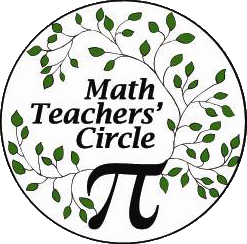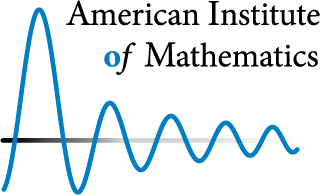
Freeing the Clones
Exploring paradox through mathematical games.
Kimberly Muller
Like the MTCircular? Subscribe to our free semi-annual magazine.
One of the biggest challenges of leading a Math Teachers’ Circle session is finding a problem that is interesting and challenging without being out-of-depth. At the Eastern Upper Peninsula Math Teachers’ Circle in Sault Ste. Marie, Mich., we ran a great session which was inspired by a Numberphile video called “Pebbling a Chessboard” or “Freeing the Clones,” by Zvezdelina Stankova (UC Berkeley).
We also ran this session for a group of high school students. We will introduce the problem and share our strategy for making it accessible at various levels.
* * *
Here is how the game works: Imagine that you are standing at the corner of an infinite checkerboard. Three clones are imprisoned in the three tiles at the corner of the board, as shown in the image at the top of the page.
The only way for a clone to move is to split itself into two clones, which will occupy the tiles above and to the right of the original clone, as shown below. Only one clone can occupy a tile at a time. For example, if the clone on the right were the first to split, its move would look like this:

Note that there are now four clones and two are still in prison. Neither of the two imprisoned clones can make the next move, because this would place multiple clones on the same tile. Therefore, the next move must be made by one of the two clones on the right.
If we continue in this manner, is it possible for all of the clones to escape the prison?
We gave teachers checkerboards from a dollar store, and had them split into groups to play the game. All but one of the groups decided it was impossible to free the clones from the prison, but they were unsure how to prove it. (The high school students were more evenly split: some believed that it could be done, but were not sure how to do it, and some thought it couldn’t be done, but believed it was impossible to prove. That led to some interesting discussions.)
Spoiler alert: In the Numberphile video, Dr. Stankova proves that it is impossible to free the clones by assigning numbers to the occupied tiles as follows:
Note that the original three clones have a total value of 2. After the first clone is split, the clones still have a total value of 2, and are, in fact, invariant. You then show that the infinite sum of all tiles outside the prison is in fact 2. In a finite number of moves, you cannot remove the clones from the prison. This solution requires the teachers to compute infinite sums.

* * *
Mathematical Appetizers
Our Circle meetings typically start off with an “appetizer” activity that we work on while we are waiting for dinner to arrive. This problem is typically a short, fun problem or activity like the Locker Problem or folding hexaflexagons. The activity is usually unrelated to the “main course” and in many cases isn’t even led by the same individual. In this particular case, the goal was for the appetizer to prepare the teachers to tackle the Freeing the Clones activity in the time allotted. To start we looked at one of Zeno’s Paradoxes, the Dichotomy Paradox:
Suppose that Homer would like to walk home. In order to do so, he must walk halfway. After he does this, he must walk half of the remaining distance, and then half that distance, etc. Since he will always have half the remaining distance to go, he will never reach home. Logically, we know that Homer can reach home. So how can we resolve this paradoxical situation?
Most participants used a graph or picture to explain why Homer could in fact make it home. This led nicely into discussions about “Proofs Without Words.” To that end, we looked at other infinite sums by shading a diagram (or creating a picture from scratch) and then deciding what sum it represented. For instance, this diagram:

represents the sum  .
.
We then made Baravelle Spirals with an empty template and some map colors. These are also fun to make in Geometer’s Sketchpad if your Circle has access to a lab.

For these Baravelle Spirals, teachers must decide what portion of the spiral is colored in a single color and what infinite sum it represents. The teachers were able to use congruent figures and repeated reasoning to determine what geometric sum these figures represented. Some were able to prove algebraically that the sums were correct. Others found the hint helpful that a similar strategy is used to determine the fractional form of the repeating decimal 0.09 = 0.09090909….
The high school students in particular enjoyed that 0.9999999…. = 1.
At this point, we began the Freeing the Clones activity with little direction. When it came to the point of assigning values to tiles that contain clones, the teachers were in a better position to solve the puzzle. The high school students needed more of a hint because they gave up much more quickly, but after telling them to think back to what we had done with Baravelle spirals, most groups were able to figure it out. In the debriefing discussion, the teachers noted that similar methods were used throughout the session, even though the problems seemed to have very little in common.
On the whole, the “appetizer” enriched the session, tying in many methods mathematicians employ, such as thought experiments, pictures, repeated reasoning, and proof.
This article originally appeared in the Winter/Spring 2017 MTCircular.
Correction: December 21, 2017
The print version of this article incorrectly assigned the number 1/16 to a diagonal on the checkerboard; the number should be 1/8.
 |
Kimberly Muller is a professor of mathematics and chair of the School of Mathematics and Computer Science at Lake Superior State University. She also serves on the leadership team of the Eastern Upper Peninsula MTC. |
MORE FROM THE
WINTER/SPRING 2017 MTCIRCULAR
![Crooked River MTC (Cleveland, OH) [1]](http://www.mathteacherscircle.org/wp-content/themes/mtc/assets/Crooked-River-MTC-Cleveland-OH-1-e1485499518808-150x150.jpg) |
A Teacher and a MathematicianMTCs have the potential to affect teachers’ beliefs about themselves and about mathematics
|
 |
A Circle in the DeltaA Math Teachers’ Circle extends a Math Science Partnership
|

|
Spot It!Spotting mathematical structure in a children’s game
|
 |
Taton Becomes Director of Mathematics for School District of PhiladelphiaJoshua Taton brings the MTC spirit to the School District of Philadelphia
|
 |
Bolognese, Davis, Phelps, Ray, Sudnick Win Ohio Teaching AwardsFive Ohio MTC members were recognized with awards from the Ohio Council of Teachers of Mathematics
|
 |
Capasso, Hill Win Presidential AwardsLiz Capasso (Fairfield County MTC) and Patty Hill (MTC Austin) win the nation’s highest recognition for math and science teachers
|

|
Danforth Presents at National ConferencesHeather Danforth (AIM MTC) presented on Math Teachers’ Circles at two conferences this fall
|
 |
A Note from AIM: Identities and ConnectionsAs the MTC Network grows larger, our understanding of how MTCs affects teachers deepens
|
 |
Dispatches from the CirclesLocal updates from across the country
|

|
OpportunitiesSpecial events, recognitions, careers
|

